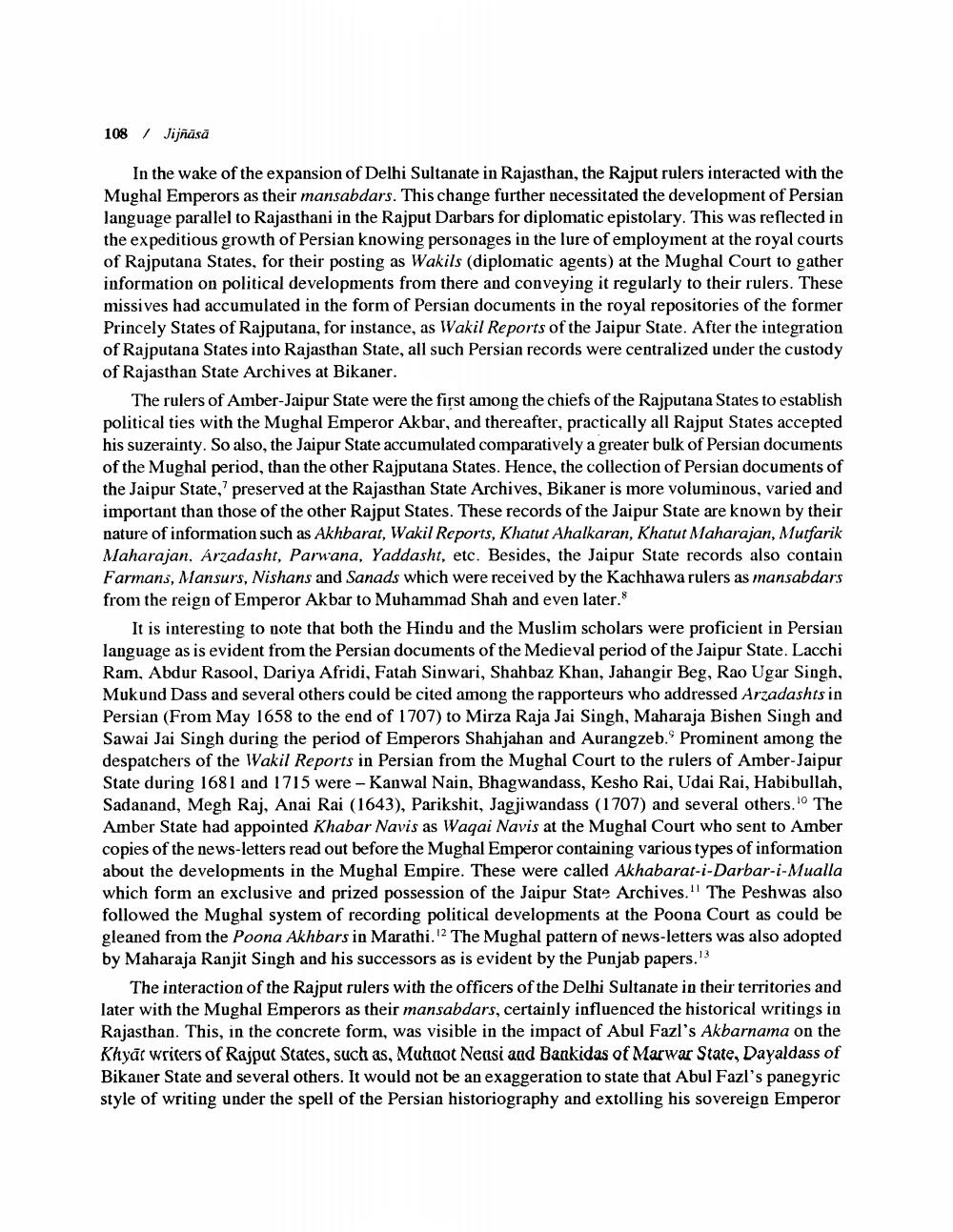________________
108/ Jijñāsā
In the wake of the expansion of Delhi Sultanate in Rajasthan, the Rajput rulers interacted with the Mughal Emperors as their mansabdars. This change further necessitated the development of Persian language parallel to Rajasthani in the Rajput Darbars for diplomatic epistolary. This was reflected in the expeditious growth of Persian knowing personages in the lure of employment at the royal courts of Rajputana States, for their posting as Wakils (diplomatic agents) at the Mughal Court to gather information on political developments from there and conveying it regularly to their rulers. These missives had accumulated in the form of Persian documents in the royal repositories of the former Princely States of Rajputana, for instance, as Wakil Reports of the Jaipur State. After the integration of Rajputana States into Rajasthan State, all such Persian records were centralized under the custody of Rajasthan State Archives at Bikaner.
The rulers of Amber-Jaipur State were the first among the chiefs of the Rajputana States to establish political ties with the Mughal Emperor Akbar, and thereafter, practically all Rajput States accepted his suzerainty. So also, the Jaipur State accumulated comparatively a greater bulk of Persian documents of the Mughal period, than the other Rajputana States. Hence, the collection of Persian documents of the Jaipur State, preserved at the Rajasthan State Archives, Bikaner is more voluminous, varied and important than those of the other Rajput States. These records of the Jaipur State are known by their nature of information such as Akhbarat, Wakil Reports, Khatut Ahalkaran, Khatut Maharajan, Mutfarik Maharajan. Arzadasht, Parwana, Yaddasht, etc. Besides, the Jaipur State records also contain Farmans, Mansurs, Nishans and Sanads which were received by the Kachhawa rulers as mansabdars from the reign of Emperor Akbar to Muhammad Shah and even later.
It is interesting to note that both the Hindu and the Muslim scholars were proficient in Persian language as is evident from the Persian documents of the Medieval period of the Jaipur State. Lacchi Ram, Abdur Rasool, Dariya Afridi, Fatah Sinwari, Shahbaz Khan, Jahangir Beg, Rao Ugar Singh, Mukund Dass and several others could be cited among the rapporteurs who addressed Arzadashts in Persian (From May 1658 to the end of 1707) to Mirza Raja Jai Singh, Maharaja Bishen Singh and Sawai Jai Singh during the period of Emperors Shahjahan and Aurangzeb. Prominent among the despatchers of the Wakil Reports in Persian from the Mughal Court to the rulers of Amber-Jaipur State during 1681 and 1715 were - Kanwal Nain, Bhagwandass, Kesho Rai, Udai Rai, Habibullah, Sadanand, Megh Raj, Anai Rai (1643), Parikshit, Jagjiwandass (1707) and several others. The Amber State had appointed Khabar Navis as Waqai Navis at the Mughal Court who sent to Amber copies of the news-letters read out before the Mughal Emperor containing various types of information about the developments in the Mughal Empire. These were called Akhabarat-i-Darbar-i-Mualla which form an exclusive and prized possession of the Jaipur State Archives." The Peshwas also followed the Mughal system of recording political developments at the Poona Court as could be gleaned from the Poona Akhbars in Marathi.2 The Mughal pattern of news-letters was also adopted by Maharaja Ranjit Singh and his successors as is evident by the Punjab papers.13
The interaction of the Rajput rulers with the officers of the Delhi Sultanate in their territories and later with the Mughal Emperors as their mansabdars, certainly influenced the historical writings in Rajasthan. This, in the concrete form, was visible in the impact of Abul Fazl's Akbarnama on the Khydr writers of Rajput States, such as, Muhaot Nensi and Bankidas of Marwar State, Dayaldass of Bikaner State and several others. It would not be an exaggeration to state that Abul Fazl's panegyric style of writing under the spell of the Persian historiography and extolling his sovereign Emperor




